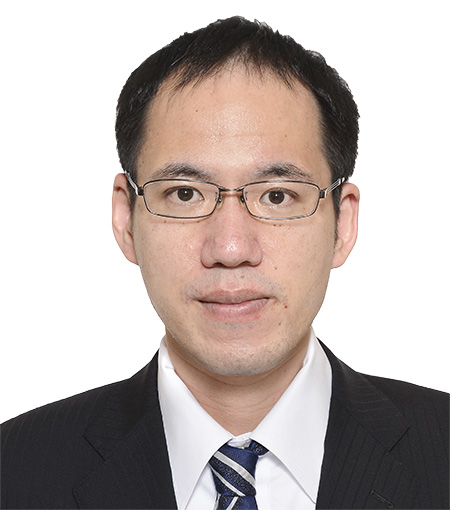- JST Home
- /
- Strategic Basic Research Programs
- /
 PRESTO
PRESTO- /
- project/
- Secure Bonding and Gentle Degradation for Sustainable Material Design/
- [Sustainable Materials] Year Started : 2022
[Sustainable Materials] Year Started : 2022
Motoyuki Iijima
Development of photo-structuring and complete dismantlement technique for glass and ceramic materials
Grant No.:JPMJPR22N1
Researcher
Motoyuki Iijima

Associate Professor
Faculty of Environment and Information Sciences
Yokohama National University
Outline
In this project, we are designing a new concept of photo-responsive slurry that enables reliable photo-crosslinking between particles in liquid with a small amount of monomer and complete disassembly of photo-cured materials down to primary particles under mild conditions in an aqueous system at room temperature. Furthermore, by utilizing this slurry, we will construct an innovative manufacturing process of glass and ceramic materials that is superior in terms of photo-structurability into arbitrary shapes, rapid manufacturing based on high-speed dewaxing and sintering operations, and raw material recycling based on complete disassembly of the photo-cured body and regeneration of the photo-curable slurry.
Reika Katsumata
Universal Cross-linkers with Ultrasound-Mediated Bond Exchange for Recyclable Network Polymers
Grant No.:JPMJPR22N2
Researcher
Reika Katsumata

Associate Professor
College of Natural Sciences
University of Massachusetts Amherst
Outline
A material design that enables reprocessing network polymers, such as thermosetting resins, is one of the most crucial challenges in materials science for realizing a sustainable society. However, conventional dynamic covalent bonds have not yet been applied to a wide range of materials because they require specific conditions for each system. To this end, this study aims to develop universal soft/hard dynamic crosslinkers that can be reprocessed by ultrasound and applicable to general-purpose resins.
Tomohiro Kubo
Functional Group Conversion for Synthesizing Degradable Polymers
Grant No.:JPMJPR22N3
Researcher
Tomohiro Kubo

Assistant Professor
School of Materials and Chemical Technology
Institute of Science Tokyo
Outline
The overarching goal of my project is to construct design principles for sustainable plastics that demonstrate both stability and controlled degradability. Specifically, I will exploit the functional group conversion to control the polymer degradation behavior. I aim to elucidate the relationship between polymer structure and function and to establish a method to introduce cleavable functional groups via post-polymerization modification and a method to upcycle waste for imparting degradable functionalities.
Yasuhiro Kohsaka
Fast Degradation of Vinyl Polymers toward On-Demand Synthesis and Dismantlement
Grant No.:JPMJPR22N4
Researcher
Yasuhiro Kohsaka

Associate Professor
Academic Assembly (Institute of Textile Science and Technology)
Shinshu University
Outline
This project develops vinyl polymers that can be synthesized and decomposed on-demand. The on-demand synthesis has already been achieved by photo-polymerization with controlled polymer properties by copolymerization technique; thus, the methodology of on-demand degradation is a main focus of this project. The key of high-speed degradation is intramolecular ester exchange reaction between the main chain and pendant groups. Ring-opening radical polymerization is applied to incorporate ester bonds into the backbone, while vinyl monomers carrying (protected) alcohol at the allylic position are copolymerized to form an alternating sequence. The intramolecular ester exchange reaction over the alternating sequence affords high-speed degradation triggered by specific stimuli. The molecular design will be applied to dismountable adhesions.
Hirokazu Kobayashi
Catalytic cleavage of stable chemical bonds toward the complete utilization of woody biomass
Grant No.:JPMJPR22N5
Researcher
Hirokazu Kobayashi

Associate Professor
Graduate School of Arts and Sciences
The University of Tokyo
Outline
Cellulose, hemicellulose, and lignin, the main components of woody biomass, are all polymers. I will develop catalytic reactions to cleave stable chemical bonds included in these polymers toward completely utilizing woody biomass. In particular, the catalysts should selectively cleave C‐O bonds linking sugar units in cellulose and strong chemical bonds in lignin. The success in this challenge will facilitate the production of fundamental chemicals from the renewable resource.
Yoichi Kobayashi
Development of composite nanomaterials that gently photodegrade strong chemical bonds
Grant No.:JPMJPR22N6
Researcher
Yoichi Kobayashi

Professor
College of Life Sciences
Ritsumeikan University
Outline
Fluorine compounds are essential materials that support our affluent life. However, they decompose only under extreme conditions and have extremely high environmental and bioaccumulative properties. In this project, I will develop composite nanomaterials that cleave strong carbon-fluorine bonds using sunlight, which does not contain deep ultraviolet light and has low light intensity. By establishing a method to decompose fluorine compounds to recyclable fluoride ions under mild conditions, I aim to realize sustainable fluorine recycling.
Masanori Shigeno
Development of decomposable aromatic polymers based on anionic activation process
Grant No.:JPMJPR22N7
Researcher
Masanori Shigeno

Associate Professor
Graduate School of Pharmaceutical Science
Tohoku University
Outline
This project aims at developing the decomposable aromatic polymers with the use of organic base catalysis. The decomposition process initially involves the degradation of sterically unhindered side chain, subsequently triggering the smooth degradation of main chain. This system has a feature of not being inhibited by the steric hindrance of the main chain unlike the conventional decomposition systems. Furthermore, this project would establish the decomposition protocol to upcycle the polymers into value added products.
Ryo Tanaka
Development of Recyclable Commodity Rubber Materials with the Degradation Initiating from Crosslinking Points
Grant No.:JPMJPR22N8
Researcher
Ryo Tanaka

Associate Professor
Graduate School of Advanced Science and Engineering
Hiroshima University
Outline
This project first aims to render commodity rubber materials both mechanical recycling ability and improved mechanical properties. This will be achieved by locating dynamic crosslinking functionalities in the specific point of the hydrocarbon polymers. Second, the crosslinking sites are designed to initiate the catalytic depolymerization reaction under specific conditions, enabling chemical recycling. In this way, this project will tackle the challenging topic in rubber material chemistry, which is a concomitant achievement of high performance, long material life, and degradability.
Shuhei Noda
Design of recycling system for biopolymers involving aromatic residues
Grant No.:JPMJPR22N9
Researcher
Shuhei Noda

Associate Professor
Graduate School of Science, Technology and Innovation
Kobe University
Outline
In this research, I will develop two technologies: biosynthesis system of polyethylene 2,5-furandicarboxylate (PEF) using Escherichia coli as a biocatalyst and development of artificial evolutionary enzymes to have extremely high polymer-degrading activity. In addition, through the development of artificial evolutionary enzymes, we will develop enzymes that can rapidly degrade various polymer materials at room temperature and pressure, and systematize them as a completely new development method for novel polymer-degrading enzymes. Finally, a microorganism that degrades polyethylene terephthalate (PET) to synthesize PEF will be developed, and a system will be developed in which polymers involving aromatic residues are circulated by E. coli.













